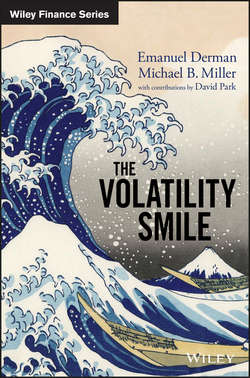The Volatility Smile

Реклама. ООО «ЛитРес», ИНН: 7719571260.
Оглавление
Park Curry David. The Volatility Smile
Preface
Acknowledgments
About the Authors
Chapter 1. Overview
Introduction
The Black-Scholes-Merton Model and Its Discontents
A Quick Look at the Implied Volatility Smile
No-Nonsense Financial Modeling
The Purpose of Models
Chapter 2. The Principle of Replication
Replication
Modeling the Risk of Underliers
The Key Question of Investing
Derivatives Are Not Independent Securities
Chapter 3. Static and Dynamic Replication
Exact Static Replication
A Simplified Explanation of Dynamic Replication
Chapter 4. Variance Swaps: A Lesson in Replication
The Volatility Sensitivity of an Option
Volatility and Variance Swaps
Replicating Volatility Swaps
Replicating Variance Swaps out of Options in a Black-Scholes-Merton World
A Portfolio of Vanilla Options with 1/K2 Weights Produces a Log Payoff
Proof That the Fair Value of a Log Contract with S* = S0 Is the Realized Future Variance
The VIX Volatility Index
Chapter 5. The P&L of Hedged Option Strategies in a Black-Scholes-Merton World
The Black-Scholes-Merton Equation
The P&L of Hedged Trading Strategies
The Effect of Different Hedging Strategies in the BSM World
Chapter 6. The Effect of Discrete Hedging on P&L
Replication Errors from Discrete Rebalancing
An Example
Conclusion: Accurate Replication and Hedging Are Very Difficult
Chapter 7. The Effect of Transaction Costs on P&L
The Effect of Transaction Costs
Analytical Approximation of the Effect of Transaction Costs
Chapter 8. The Smile: Stylized Facts and Their Interpretation
Smile, Term Structure, Surface, and Skew
How to Graph the Smile
Delta and the Smile
Chapter 9. No-Arbitrage Bounds on the Smile
No-Arbitrage Bounds on the Smile
Chapter 10. A Survey of Smile Models
An Overview of Smile-Consistent Models
Problems Caused by the Smile
Chapter 11. Implied Distributions and Static Replication
Implied Distributions
The Breeden-Litzenberger Formula
Static Replication: Valuing Arbitrary Payoffs at a Fixed Expiration Using Implied Distributions
The Black-Scholes-Merton Risk-Neutral Probability Density
Chapter 12. Weak Static Replication
Summary of the Book So Far
Introducing Weak Static Replication
Some Insights into the Static Replication of Barrier Options
Another Approach: Static Replication of an Up-and-Out Call
Chapter 13. The Binomial Model and Its Extensions
The Binomial Model for Stock Evolution
The Binomial Model for Options Valuation
Extending the Black-Scholes-Merton Model
Chapter 14. Local Volatility Models
Modeling a Stock with Variable Volatility
Binomial Local Volatility Modeling
The Relationship between Local Volatility and Implied Volatility
Difficulties with Binomial Trees
Further Reading
Chapter 15. Consequences of Local Volatility Models
Dupire's Equation for Local Volatility
Understanding the Equation
A Binomial Derivation of the Dupire Equation
A More Formal Proof of the Dupire Equation
An Exact Relationship between Local and Implied Volatilities and Its Consequences
Chapter 16. Local Volatility Models: Hedge Ratios and Exotic Option Values
Hedge Ratios in Local Volatility Models
The Theoretical Value of Exotic Options in Local Volatility Models
Chapter 17. Some Final Remarks on Local Volatility Models
The Pros and Cons of Local Volatility Models
Testing the Local Volatility Model for Index Options
Chapter 18. Patterns of Volatility Change
Heuristic Relationships between the Slope of the Skew and Its Dynamics
Toward Stochastic Volatility Models
Chapter 19. Introducing Stochastic Volatility Models
Introduction to Stochastic Volatility
A Heuristic Approach for Introducing Stochastic Volatility into the Black-Scholes-Merton Model
Chapter 20. Approximate Solutions to Some Stochastic Volatility Models
Extending the Local Volatility Model
Extending the BSM Model: Valuing Options with Stochastic Volatility via the Replication Principle
The Characteristic Solution to the Stochastic Volatility Model
Chapter 21. Stochastic Volatility Models: The Smile for Zero Correlation
The Zero-Correlation Smile Depends on Moneyness
The Zero Correlation Smile Is Symmetric
Two-State Stochastic Path Volatility: An Example
The Smile for GBM Stochastic Volatility with Zero Correlation
Chapter 22. Stochastic Volatility Models: The Smile with Mean Reversion and Correlation
Mean-Reverting Volatility with Zero Correlation
Nonzero Correlation in Stochastic Volatility Models
Comparison of Hedge Ratios under Black-Scholes-Merton, Local Volatility, and Stochastic Volatility
Best Stock-Only Hedge in a Stochastic Volatility Model
Concluding Remarks
Further Reading
Chapter 23. Jump-Diffusion Models of the Smile: Introduction
Jumps
Modeling Pure Jumps
Chapter 24. The Full Jump-Diffusion Model
Jumps Plus Diffusion
Trinomial Jump-Diffusion and Calibration
Valuing a Call in the Jump-Diffusion Model
A Mixing Formula
A Qualitative Description of the Jump-Diffusion Smile
A Simplified Treatment of Jump-Diffusion with a Small Probability of a Large Single Jump
Further Thoughts and Reading
Epilogue
Appendix A. Some Useful Derivatives of the Black-Scholes-Merton Model
Appendix B. Backward Itô Integrals37
Standard Integration
Stochastic Integration
Appendix C. Variance Swap Piecewise-Linear Replication
Answers to End-of-Chapter Problems
References
Index
WILEY END USER LICENSE AGREEMENT
Отрывок из книги
The Volatility Smile
EMANUEL DERMAN
.....
Science – mechanics, electrodynamics, molecular biology, and so on – seeks to discover the fundamental principles that describe the world, and is usually reductive. Engineering is about using those principles, constructively, to create functional devices.
What about financial engineering? In a logically consistent world, financial engineering, layered above a solid base of financial science, would be the study of how to create useful financial devices (convertible bonds, warrants, volatility swaps, etc.) that perform in desired ways. This brings us to financial science, the putative study of the fundamental laws of financial objects, be they stocks, interest rates, or whatever else your theory uses as constituents. Here, unfortunately, be dragons.
.....